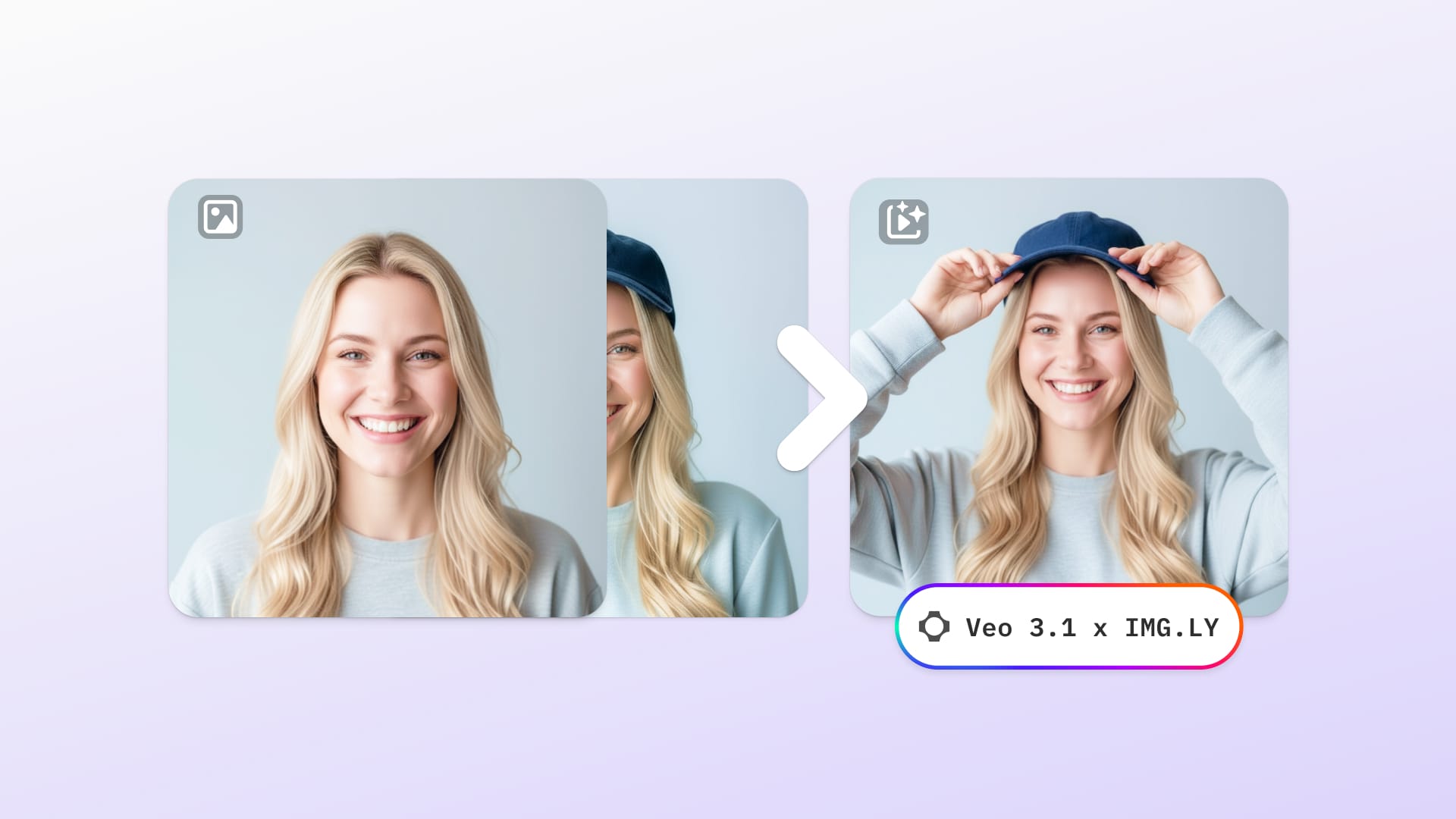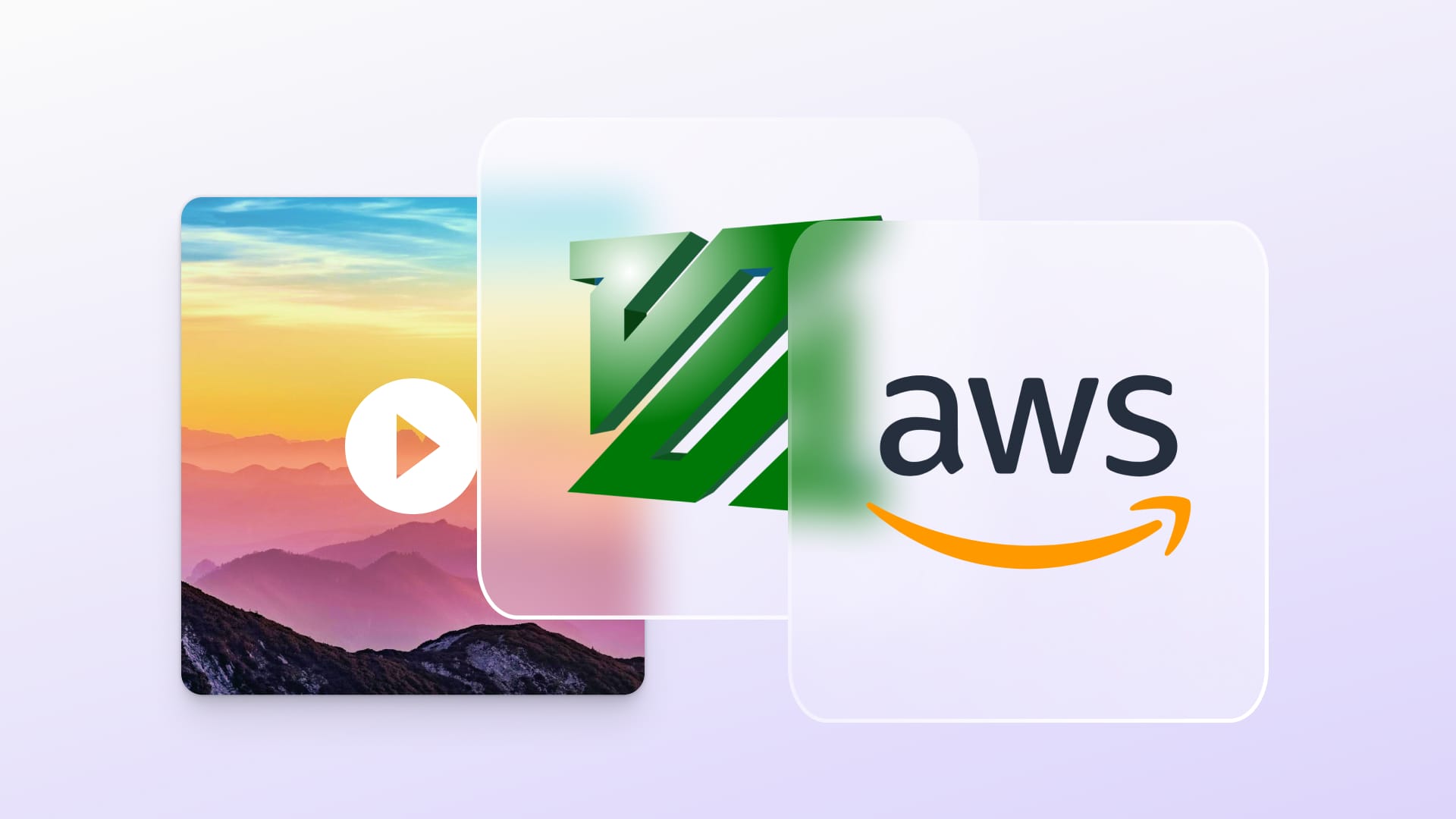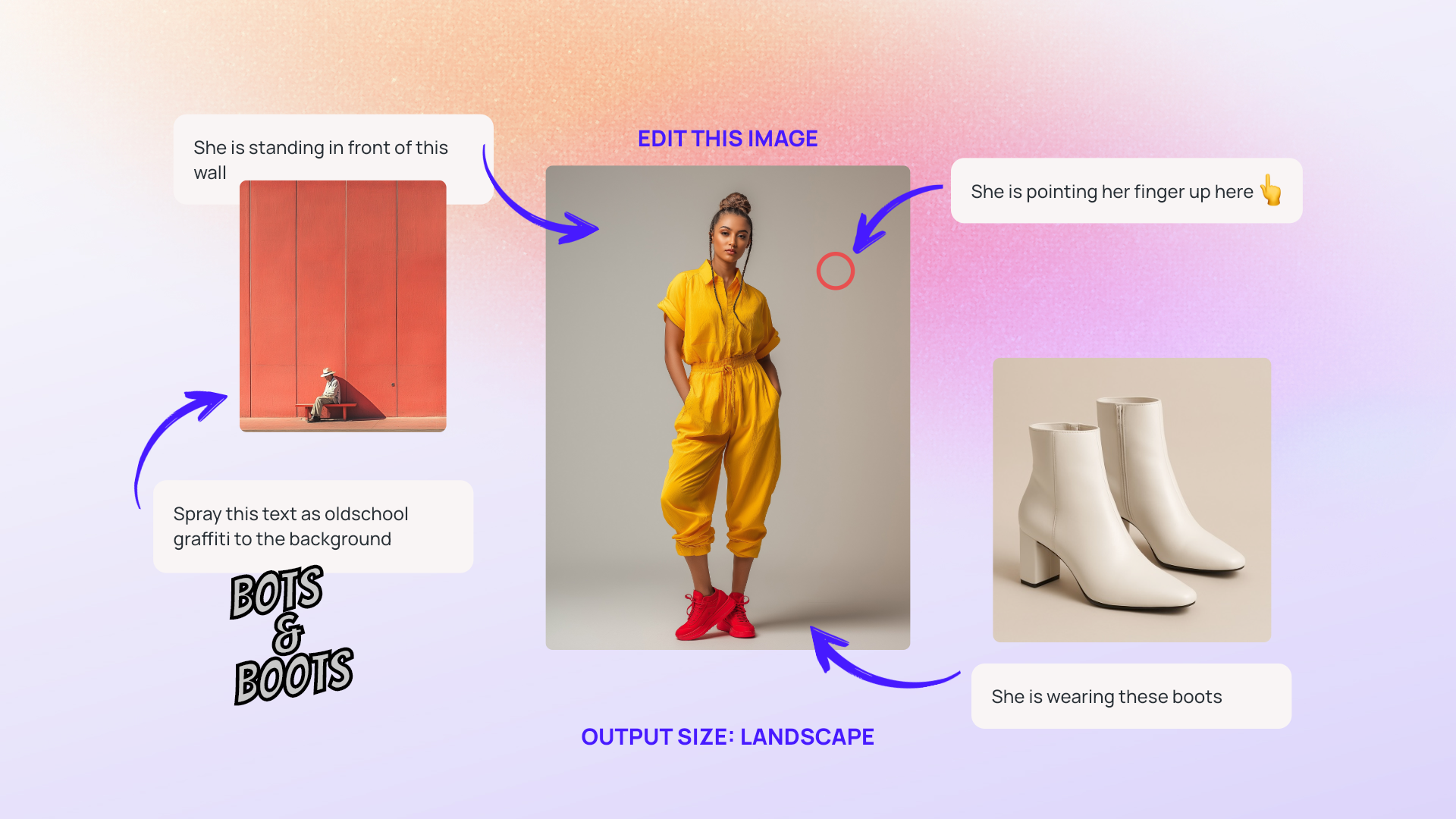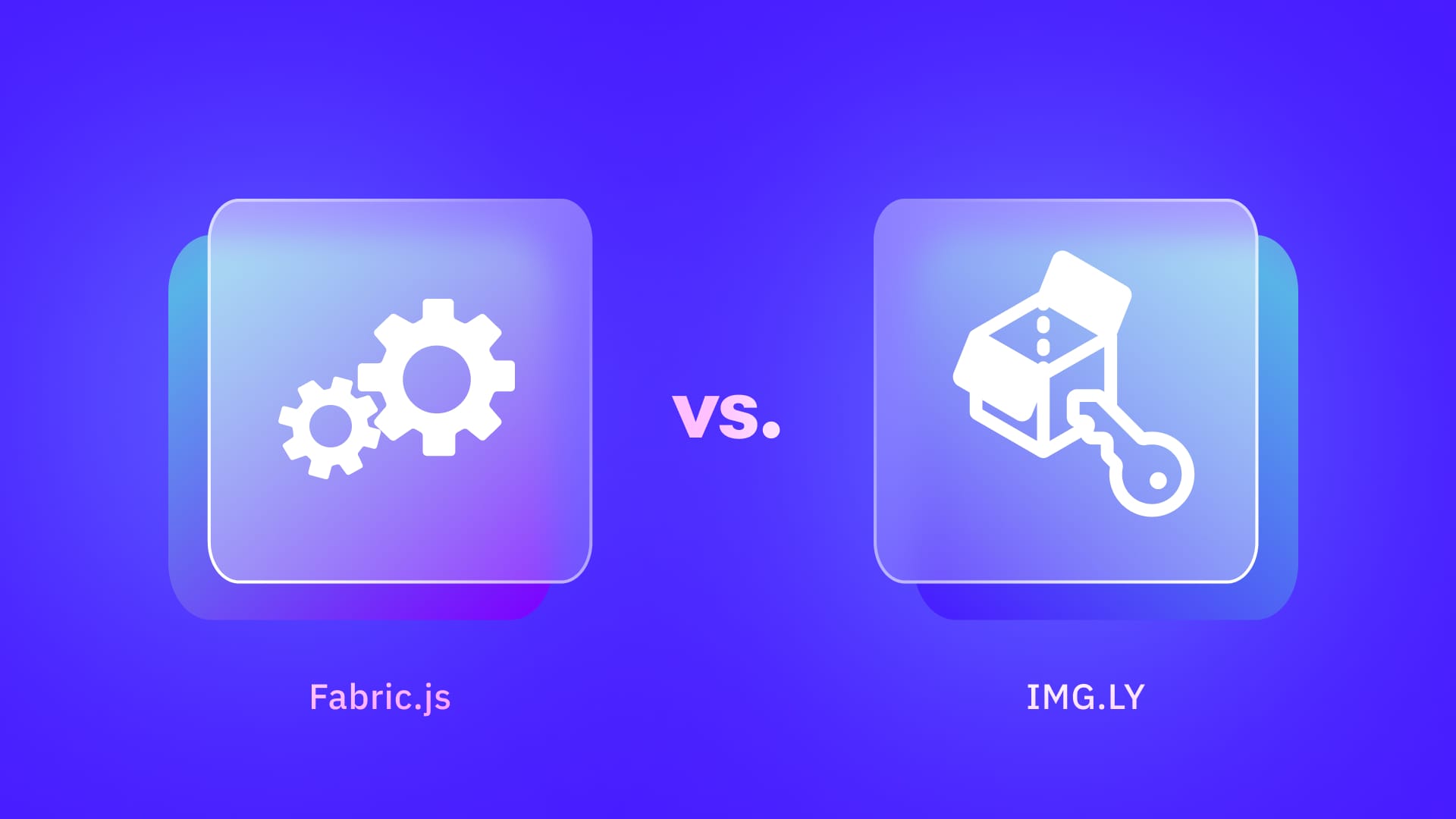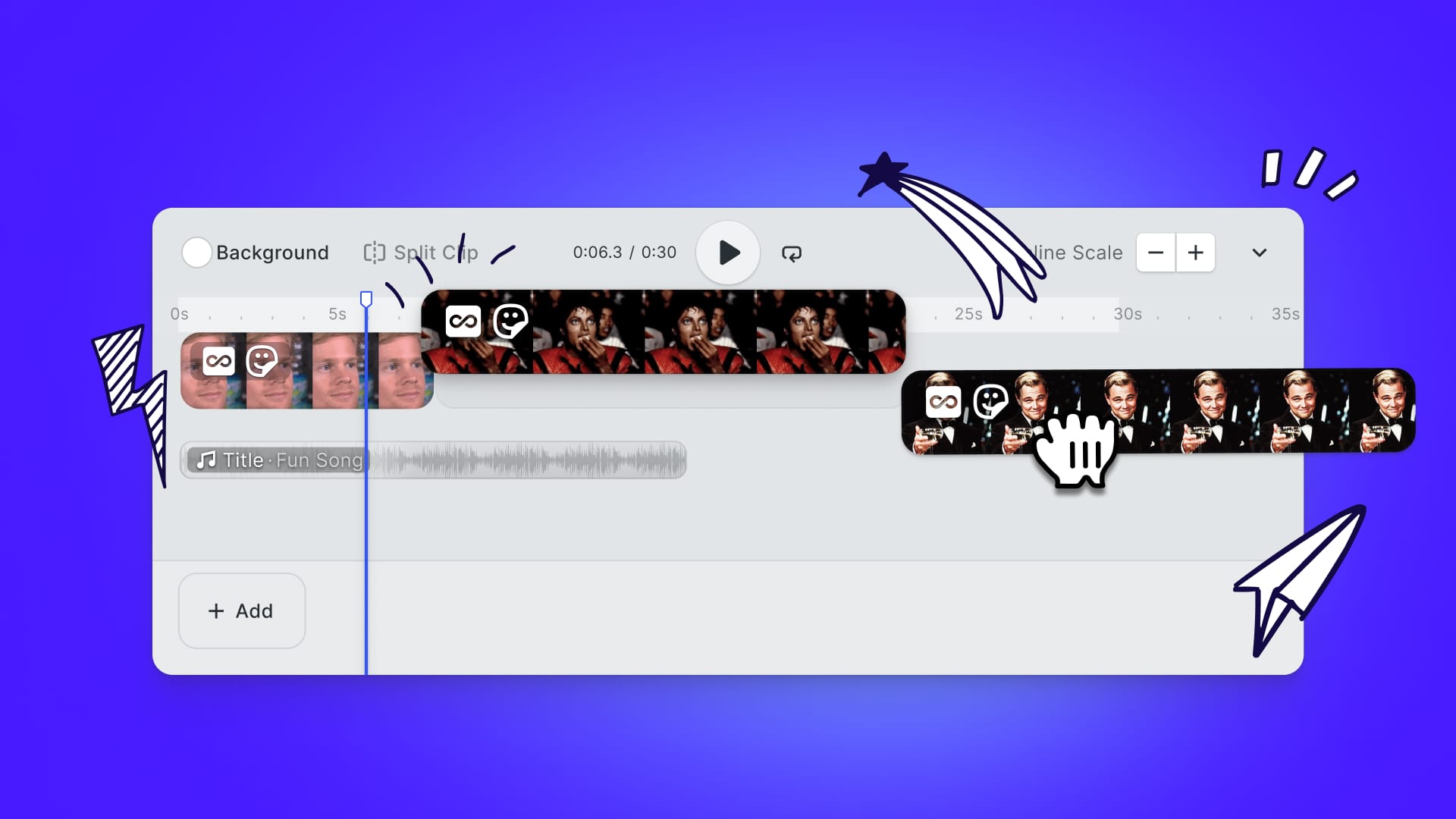When developing or integrating a JavaScript-based video editor for the web, you must consider a number of factors to ensure the solution is both efficient and robust. This post is the definitive guide for anyone embarking on such a project. It explores the key technologies involved, their strengths and weaknesses, and how different use cases influence the choice of tech stack. We'll examine diverse use cases, from lightweight, browser-based editors for quick edits to more advanced tools requiring complex processing and rendering. We'll then discuss how these scenarios drive the selection of features and technology.
Additionally, we will show you the best open-source solutions that can accelerate development. This technical analysis will help you make an informed "build vs. buy" decision, ensuring you select the right approach for your project. Throughout this post, we will use the example of the IMG.LY's JavaScript video editor (see here for a demo), showing you how these considerations shaped its architecture and feature set. You will learn practical insights into the decision-making process behind a successful web-based video editor.
Modern web technologies like WebGL, WebCodecs and WebAssembly have enabled browsers to efficiently perform resource-intensive tasks such as video editing that had hitherto been the sole domain of desktop applications. As a result Javascript based video editing tools such as veed.io have increased in popularity and users expects ever more sophisticated video editing capabilities inside modern video based web apps.
Video Editing Use Cases
Let’s first outline use cases and requirements of video editing applications on the web. These will inform our discussion of technical features of respective solutions below and grant a conceptual framework for evaluating potential benefits and drawbacks of each solution.
Simple Video Editing
Let’s start with the base case, simple video edits including trimming, cropping and resizing and simple effects such as adjusting brightness or saturation. This is usually sufficient feature set to support video editing for the following use cases:
Sales Outreach Videos: Sales teams often need to quickly edit customer-specific videos to personalize their outreach. This may involve trimming irrelevant portions, adding company logos, or adjusting brightness to ensure visual clarity.
Messaging Applications: These often require basic editing tools to allow users to crop, trim, or apply simple filters to shared videos, ensuring they’re concise and visually appealing.
Screencasting: Screencasting tools benefit from trimming and resizing capabilities to focus on key parts of recorded screens. Adding effects like brightness adjustment can make tutorials clearer and more professional.
CMS Systems: Content management systems may offer built-in video editing to help users optimize media assets for specific platform requirements, such as resizing for web embeds or adding subtle branding.
Screen Recording Applications: Screen recording applications often include simple editing options for cleaning up recorded content by trimming extraneous sections or cropping to highlight the most relevant parts.
Video Annotation
Next, users might want to add an additional layer of information to videos and overlay other assets, such as stickers, shapes, overlays, or text. Crucially these assets need to be time-based—that is, users need control over when the asset is shown so that particular video sequences can be referenced. This introduces the need for a timeline to arrange different video components relative to each other in time, as well as features like voice-over and audio track support.
E-commerce Reviews: Sellers and reviewers can annotate product demo videos with callouts, price tags, and feature highlights to make the content more engaging and informative.
Claims Management / Insurance: Insurance companies can use annotation to highlight key details in submitted video claims, such as timestamps of damage or explanatory text overlaying critical sections of footage.
Real Estate: Realtors might annotate property walkthroughs by adding labels, dimensions, or descriptive text overlays to highlight key features of the home or property.
Educational Applications: Instructors can use annotation tools to emphasize key moments in lectures or tutorials, such as overlaying text with formulas or concepts, or adding visual shapes to guide attention.
Productivity Tools: Users can annotate meeting recordings with timestamps, text notes, or overlay diagrams to summarize key decisions or action points.
Healthcare and Telemedicine: Medical professionals might annotate diagnostic videos or procedure recordings to explain findings or highlight areas of interest for training purposes.
Customer Support & Onboarding Tools: Companies can add annotations to video tutorials or troubleshooting guides to direct users through specific steps or highlight important information.
Video Composition
As we’re moving away from single media editing to creating video compositions of several types of media such as audio tracks, text, images, animations, and effects to create appealing visual designs, a well-designed timeline becomes even more important. Users need to manage many different video components in time, requiring user-friendly ways to browse and integrate external assets. This editor variant is most relevant for the following use cases:
Marketing Tech (Promotional Videos): Marketers can create visually stunning promotional videos by combining custom animations, background music, and text overlays for branding.
Social Media (Stories and Reels): Social media creators can quickly craft short, engaging videos that combine multiple assets like stickers, animations, and dynamic transitions tailored to platform-specific formats.
Event Highlight Reels: Event organizers can compile videos, photos, and music into cohesive highlight reels that encapsulate the essence of the occasion.
Template-based Video Creation
For many applications, users need starting points and examples for their designs. Starting from a blank canvas is rarely necessary for most use cases. Take a simple product video that includes promotional text, a brand logo, and animations. There is no need to reinvent the wheel for these types of videos. Instead, design applications should offer template libraries to accelerate user workflows.
Once we introduce workflows involving several stakeholders—such as designers setting up a certain brand framework and marketers working with and adapting these preconfigured designs—templates need to be able to constrain what edit operations adaptors can perform. These requirements are particularly important for these use cases:
Digital Asset Management: Organizations can manage and deploy branded video templates across teams, ensuring consistent design and messaging.
Social Media Publishing: Social media managers can utilize templates for quick turnaround on platform-specific video formats, such as Instagram Stories or LinkedIn posts.
Marketing Tech: Marketing teams can rely on pre-designed templates to churn out campaign videos at scale while maintaining brand consistency.
Training Videos: HR or L&D departments can adapt existing templates to quickly produce training materials customized for different teams or scenarios.
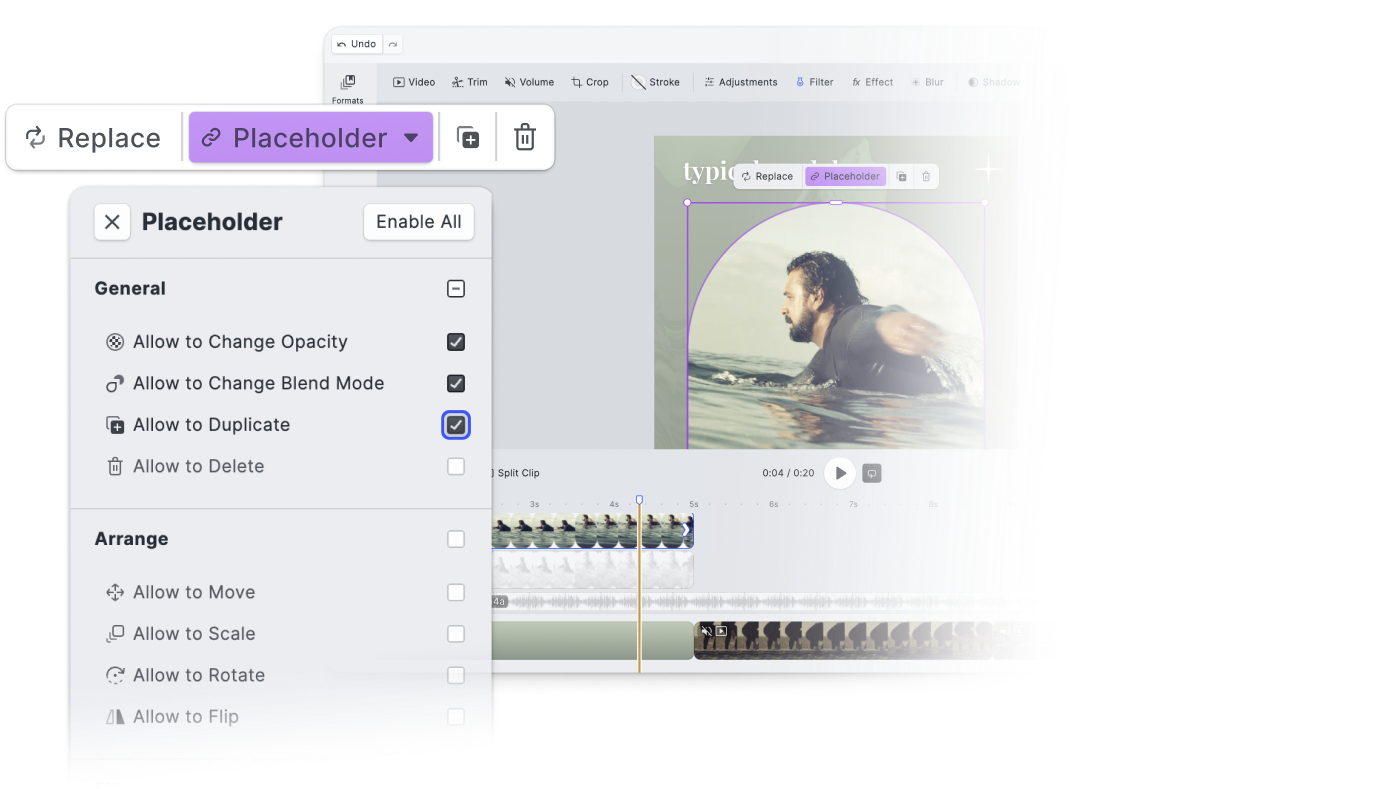
Creative Automation for Video
Finally, you can leverage data and automation to generate variations of your templates at scale, significantly boosting the productivity of use cases where users need to either test a large number of designs, publish to different channels with different requirements, or adapt designs to many slightly different instances, for example, menu designs for a franchise.
Marketing Tech: Marketers can generate hundreds of ad variations for A/B testing or localization by dynamically adjusting text, visuals, or calls to action.
Social Media Publishing: Social media teams can automate the creation of videos tailored to platform specifications, such as aspect ratios or resolution, while retaining core branding.
E-commerce: Retailers can produce personalized product showcase videos for different customer segments, featuring tailored offers, pricing, or recommendations.
Hospitality Industry: Hotels and restaurants can dynamically generate location-specific promotional videos showcasing seasonal offers, menus, or events.
Essential Video Editing Features
The above use cases are enabled by a set of features from simple transforms to complex compositions. Some video editors are focused more on manipulating individual video clips while others are more oriented towards video creation providing fully-fledged multi-media composition tool. This concise overview serves as a reference for evaluating video editing solutions:
Transforms
- Cut, Trim, and Split: Basic editing tools for segmenting video clips.
- Resize and Scale: Adjusts clip dimensions, ensuring proper fit or aspect ratio.
- Crop and Rotate: Controls framing and orientation.
- Zooming Capabilities: A UX feature enabling detailed editing and close-up views for precision.
Adjustments
- Basic Adjustments: Controls brightness, contrast, and other visual enhancements.
- Filters and Effects: Sets the visual appearance and atmosphere of videos.
- Audio Tracks and Mixing: Supports multi-track audio adjustments and volume balancing.
- Text and Overlay Options: Allows visual enhancements with text, captions, and emojis, providing opacity and layering options.
Composition
- Multi-media Composition: Overlaying images, stickers, text as well as audio tracks are essential for creating videos through composition.
- Multi-Track Editing: Elements and layers need to be position relative to each other in time allowing the creation of complex composition.
- Canvas-Based Editing: Provides a flexible workspace for positioning and layering media elements.
- Timeline Management: Split, join and arrange clips on a timeline. Manages the positioning of clips and timing for seamless transitions.
- Animations: Make static elements dynamic and control their behavior in time. Can be use to create videos from scratch and enhance the storytelling workflow of existing ones.
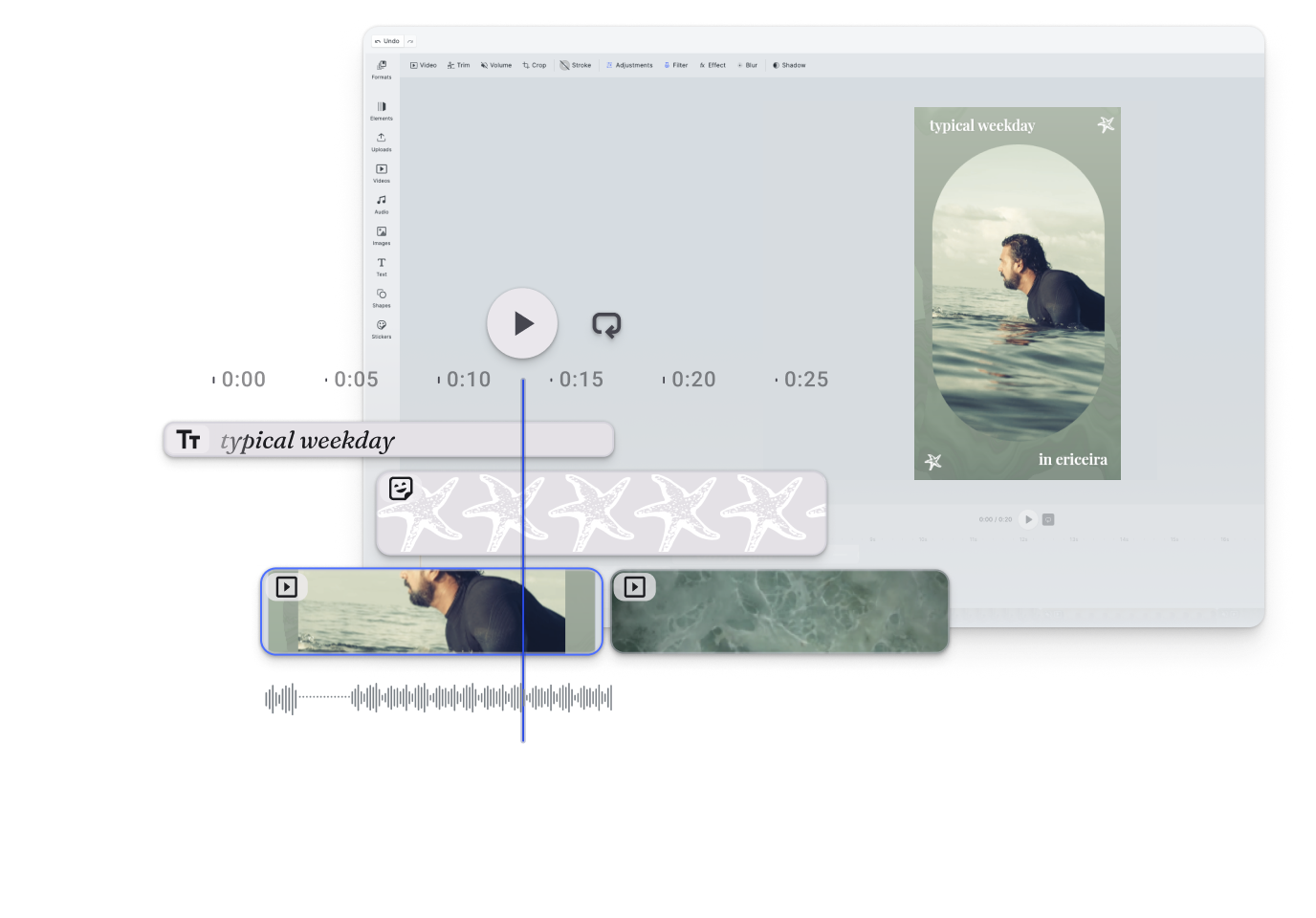
The Technology Landscape
Some time in the early 2000s the web started to be viewed as a platform to run applications not just a distributed database to deliver static html documents. While Javascript development was not yet at a point to serve as foundation for the kind of application development we see today, Adobe Flash filled the role of development platform. Video editing in the early days of the web was mainly provided by Flash-based tools involving simple transform operations such as trimming and basic transitions. Java applets were another way to deliver processing intensive programs via the browser while executing them outside of the browser inside the JVM. These early attempts were either too clunky, since they could not run natively in the browser or lacked the performance to be useful for high quality editing.
When HTML5 came onto the scene in the early 2000s it became possible to handle multimedia content natively in the browser. Coupled with significant performance advances of Javascript and the introduction of WebRTC this opened the door for video editing on the web.
Some early cloud-based editors, such as WeVideo and Magisto, while more convenient and user-friendly than its predecessors still suffered from performance issues due to latency and lacked the depth of features found in desktop software.
In the past few years advances such as WebAssembly and Javascript libraries built upon it e.g. ffmpeg.js have revolutionised browser-based video editing. User can now perform complex editing tasks like multi-track timelines, video effects and real-time in-browser rendering. Modern web-based solution have even come to rival desktop apps, because they can take advantage of GPU acceleration, modern APIs like WebGL and UI frameworks such as React.
Let’s have a look at the state of the art web technologies that allow us to create performant video editing experiences inside the browsers. We are going to explore their relative strength, their complexities and conclude with when to best use each of these technologies:
Canvas API
The HTML5 Canvas API should be most familiar to most modern web developers, since it’s a familiar and popular way to render 2D graphics in the browser. It’s use for video editing is limited and restricted to simple overlays, trimming, composition and animation:
- Complexity: Canvas is the least complex of the technologies introduced below and overlaps with the WebGL feature set to some extend, it’s API is well-known to most web developers.
- Advantages: Canvas is lightweight, compatible across all browsers, and easy to implement, making it a great choice for simple use cases that require basic effects and no timeline.
- Downsides: While well suited for simpler tasks Canvas lacks the GPU-acceleration of WebGL, hence it is not recommended for resource intensive operation or performance sensitive use cases.
- When to Use: Choose Canvas for simple editing tasks, like trimming or basic overlays, or if you need a fallback technology that works well on legacy browsers and devices.
WebGL
WebGL opens up the power of GPU-accelerated graphics to the browser, making it the default choice for any use case requiring high performance rendering. As such modern Javascript video editing solution are well served by webGL when looking to render visual effects in real time, add transitions or facilitate multi-layer compositions by leveraging the GPU.
- Complexity: WebGL comes with a steep learning curve especially if you are unfamiliar with 3D graphics processing, shaders and GPU programming.
- Advantages: WebGL delivers high performance for processing complex video effects and can handle significant volume of data without latency. That makes it ideal for advanced, highly responsive video editing features.
- Downsides: It can be challenging to engineer modular and maintainable WebGL code, debugging shaders and ensuring consistent performance across devices is an art in itself. WebGL might also be overpowered for simple editing use cases that do not justify the added complexity.
- When to Use: Use WebGL if you’re creating a video editor with high-performance demands, particularly if real-time effects, transitions, or multi-layer compositing are needed.
WebCodecs API
Next up in our arsenal of formidable web technologies is a recent addition to modern browsers, WebCodecs, provide direct access to hardware accelerated video encoding and decoding.
The WebCodecs API is a recent addition to the browser, allowing direct access to hardware-accelerated video decoding and encoding. This API makes it easier to handle high-resolution video without delays, thanks to efficient decoding directly in the browser.
- Complexity: WebCodecs is relatively easy to use for those familiar with media formats. However, you may need other technologies for rendering and complex editing.
- Advantages: This API offers quick access to hardware acceleration, ideal for managing large video files. With it, you can efficiently handle high-definition video playback and streaming.
- Downsides: Browser support for WebCodecs is still expanding, so compatibility might be a concern. Additionally, WebCodecs alone doesn’t provide a full editing suite; it needs to be combined with rendering and compositing technologies.
- When to Use: WebCodecs is perfect if you need efficient decoding and encoding, especially for handling high-definition playback or live streaming.
WebAssembly (Wasm)
The next performance frontier browser pushed towards was enabling near-native performance by compiling languages like C++ or Rust into a format that efficiently runs in Javascript. This format is WebAssembly, which makes it possible to handle computationally expensive tasks like encoding, decoding or frame manipulation inside the browser.
- Complexity: Working with WebAssembly is significantly more complex that the technologies discussed above. Developers need knoweldge of C++ or Rust as well as experience compiling to Wasm.
- Advantages: WebAssembly enables browsers to handle complex video processing tasks, such as encoding and decoding, with near-native performance. Libraries such as FFmpeg build upon WebAssembly to make familiar video tools available to web developers.
- Downsides: Development with Wasm is complex, and debugging can be a challenge. Additionally, Wasm modules may increase load times.
- When to Use: Use WebAssembly when building native libraries for complex operation and expensive computations, such as encoding and decoding.
Our article on building a video editor with React and Wasm gives you a real-world starting point for your own apps.
MediaStream API
The MediaStream API is essential for gaining easy access to live video sources from within the browser, such as webcams. If your video editing app includes a feature for real-time recording or streaming the MediaStream API is an essential tool.
- Complexity: MediaStream exposes a fairly simple API and is relatively easy to learn for experienced web developers.
- Advantages: This API is well-suited for video feeds with low latency such as recording or streaming and does require addition encoding or decoding.
- Downsides: Any use case requiring post-production video has to rely on additional technologies or frameworks, as the MediaStream API is limited to live feeds. The quality of the stream depends on the input source and can vary.
- When to Use: Use MediaStream for applications with live recording or streaming functionality.
Web Audio API
The final web technology essential for video editing is the Web Audio API. Whether you want to add effects or mix multiple audio tracks, this API offers sophisticated tools for audio manipulation.
- Complexity: For developers unfamiliar with audio processing the learning curve can be stepp, however the API is well designed and there is a host of educational resources.
- Advantages: Web Audio API allows precise control over audio enabling your app to offer audio adjustments such as effects or reverb and multi-track editing.
- Downsides: It can be challenging to accurately synchronize audio with video, especially if your app includes a real-time component.
- When to Use: Opt for Web Audio API when audio editing is a core feature of your video editor.
Using These Technologies Together
Together, these technologies can be use to build a comprehensive browser based editor that is virtually indistinguishable from its desktop based counterparts. Different parts of the video editing workflow can be handled by each technology, while some choices have to made depending on the complexity and requirements of your projects, e.g. whether you’ll need resource intensive processing or an integration will real-time sources.
- Video Decoding - WebCodecs API (for efficient video loading and playback).
- Rendering - WebGL (for high-performance effects) and Canvas API (for simpler editing features).
- Complex Processing - WebAssembly (for encoding/decoding and using native libraries like FFmpeg).
- Audio Processing - Web Audio API (for mixing and adding effects to soundtracks).
- Live Recording - MediaStream API (to capture live video from devices).
Open Source Javascript Video Editing Libraries
Fortunately in many cases someone has already done the heavy lifting and abstracted those browser APIs into simple to use libraries and frameworks. We’ll explore the most prominent ones distinguishing between projects that are for processing raw video and those that already provide an API for you to use. It is important to note that the libraries introduced below do not provide a video editing UI, unfortunately there are no open source video editors offering an end user interface that meet the standards for inclusion in a production grade application. None of the projects we evaluated met the demands we place on third-party libraries with respect to robustness, stability, maintenance and future development. However many can provide good starting points and references on how to build your own UI such as Reactive Video for React UIs.
FFmpeg.js
FFmpeg.js is the JavaScript port of the popular FFmpeg library compiled into WebAssembly. It enables developers to manipulate and process raw video files entirely in the browser. You can trim, convert formats, extract audio, and apply filters to videos without needing external software. However, FFmpeg just gives you the raw toolchain for building video editing features, you are still tasked with building the entire UX and editing workflows. We have an extensive guide on FFmpeg that you can consult to explore its capabilities and get started learning FFmpeg syntax.
- Advantages:
- Most comprehensive library for web based video and audio processing.
- Fully client-side, no need for server-side processing.
- Highly flexible, allowing fine-grained control over video workflows.
- Downsides:
- Fairly complex for beginners with a steep learning curve, requires familiarity with FFmpeg’s command-line syntax.
- FFmpeg is licensed under LGPL which makes it ill-suited for most commercial projects.
- When to Use:FFmpeg.js is best suited for projects with custom requirements and UI making it necessary to exert fine-grained control over video processing tasks, especially for use cases like format conversion, advanced editing pipelines, or serverless video workflows.
The following two libraries allow you to programatically create and edit videos, we focus on the most stable, popular libraries here, while there might be promising up and comers we want to ensure a degree of dependability of the third-party code to be used in production systems.
Remotion
Remotion is a React-based framework that enables developers to edit or create videos programmatically in a declarative fashion using React components. React’s declarative syntax makes it comparatively simple to manage video content and Remotion provides a convenient UI for previewing and editing videos. While its studio UI cannot be embedded directly, Remotion can serve as the graphics processing engine for custom UIs. Although it is a commercial project, it offers a generous free tier for individuals and small businesses.
- Advantages:
- Leverages React's declarative model for seamless video creation.
- Provides robust video preview capabilities for iterative development.
- Flexible integration with custom-built UIs.
- Generous free tier for non-commercial and small-scale projects.
- Downsides:
- The built-in studio UI cannot be embedded, requiring developers to create their own UI for embedding.
- React-specific, limiting use in non-React environments.
- When to Use:Use Remotion when building React-based video applications that require programmatic video generation or dynamic video content. It’s ideal for teams already familiar with React and for applications where embedding is not a core requirement.
Etro.js
Similarly to Remotion, Etro.js is a JavaScript framework for programmatic video editing, it is framework agnostic and provides an API for simple composition of layers, effects and exporting videos.
- Advantages:
- Includes support for advanced effects using GLSL shaders.
- Designed for in-browser video workflows.
- Downsides:
- Minimal community support compared to larger projects.
- Requires additional effort to create a full UI.
- When to Use: Suitable for applications where programmatic control and customization are key.
Extensibility
An important consideration when deciding to buy a prebuilt video editing solution is the degree of customization and extensibility required by your use case versus how critical speed to market is. While most SDKs provide enough flexibility by exposing cor API to build a solution that best suits your needs, this level of technical control comes at the expense of higher development and maintenance efforts. White-label solutions on the other end of the spectrum offer limited customization often relying on iFrames for embedding while providing maximum speed to market. If you are still in the phase where you need to make the business case for video editing features these might be key to allowing to quickly iterate. To learn more about weighing the pros and cons of SDK vs. White-label explore our extensive guide on the topic.
IMG.LY's CE.SDK achieves extensibility by providing an interface for plugins that allow developers to add custom features and UI elements.
Cross Platform Video Editing
While this post is dedicated specifically to Javascript video editing an important consideration for choosing a video editing tech stack is whether there exists an intermediary output format that preserves editing operations so that videos can be edited on other devices and platforms. This is important for collaborative video editing use cases as well as use cases where videos are captured and basic edits performed on mobile and the finishing touches performed on the desktop.
These consideration are particular pertinent for the Real Estate, Telemedicine and Productivity use cases described above, since they involve either a multi-device or collaborative component.
At most common libraries or SDKs can achieve that by offering support for some form of serialization, that is exporting the edit operations along with the unedited video to then reapply edits upon import.
IMG.LY’s CE.SDK, on the other hand, is the only video editing SDK that is truly cross-platform. That means it is built atop a single creative engine that is portable to any platform. Whether iOS, Android, Desktop, or the Web, every platform uses the same underlying tech and uses the same custom format for scenes which contain all assets and edits making error-prone serializations obsolete.
Furthermore:
- iOS and Android make use of the same underlying API.
- Cross platform feature parity is baked into the cake. Since core functionality is implemented at the engine level, features are guaranteed to be available on both platform, although the timeline might differ somewhat.
- Designs are 100% interoperable and consistent between platforms. Exporting and importing design files across platforms works seamlessly and final renderings are guaranteed to be consistent.
Javascript Video Editing & Generative AI
Generative AI is impacting video editing and generation across the board. Video generation obvious application of generative AI, but AI is also changing the way we we compose, create an edit videos in more subtle ways.
Features such as automated transitions, color grading, voice enhancement, voice over generation, background removal or inpainting are
Currently, these capabilities are offered by multiple specialized providers, such as ElevenLabs and OpenAI's Sora. Firstly, that means modern Javascript video editors need to be open enough to serve as integrators for various, programmatically combining voice tracks, video clips, text, audio and other media before presenting users with an editing UI. Secondly, traditional video editing needs to enable the human in the loop. AI is still imperfect and manually refining unchangeable artifacts through prompts is inefficient and tedious. Instead the output by AI must remain editable and any editor solution smoothly interface with those artifacts to allow users to add the necessary polish, swap out media and regenernate individual parts of the scene.
To explore what this might look like in practice have a look at our CEO Eray Basar’s latest project building an AI video generator on top of CE.SDK.
Conclusion
When building or integrating a JavaScript video editor, developers and PMs have to navigate a complex technology landscape and make myriad decisions along the way. This guide has covered everything from essential use cases and feature sets to the cutting-edge technologies that underly browser-based video editing. Whether your project requires basic trimming tools or advanced multimedia composition, understanding the benefits and downsides of the various solutions like Canvas, WebGL, WebCodecs, WebAssembly, and more is crucial for choosing the right stack.
We've also explored how open-source tools like FFmpeg.js, Remotion, and Etro.js can accelerate development, while SDKs like IMG.LY’s CE.SDK offer unmatched extensibility and cross-platform compatibility. For those navigating the impact of generative AI on video editing, the need for seamless integration and user-centric design remains important.
If you’re looking for a robust, modern video editing solution for your web application, explore our showcase and start a free trial.



